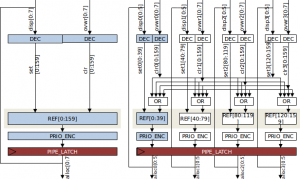| AfterBurner: Efficient Performance Scaling via Post-Retirement Processing |
| The AfterBurner project looks at improving single-thread performance on both simple and high-performance out-of-order cores in an energy efficient way. Aside from explicit parallelism, this is the primary challenge of multi-core architectures going forward.
The most energy-efficient way to improve single-thread performance is to accelerate low-performing program regions. This approach yields the yields the greatest benefit. It also has a low cost because it doesn’t require high-bandwidth execution, making it applicable to both simple and high-performance cores. Low single-thread performance is caused by squashes due to control and data mis-speculations and by long latency loads and stores which clog the pipeline. The AfterBurner project also looks at schemes to improve energy-efficiency of existing resources in our-of-order cores. For example, register reference-count bit-vectors are used to manage register-file state instead of conventional free-list FIFOs. These structures support register steering which is a key enabler for coarse-grained register-file VDD-gating. AfterBurner’s multi-purpose infrastructure approach to performance and energy-efficiency reduces cost, simplifies design, and expands applicability to code that suffers from different low-performance events simultaneously. Collaborators: Amir Roth, UPenn/DoE, Andrew Hilton, Duke |
Publications:
- Steven Battle and Mark Hempstead, Register Allocation and VDD-gating algorithms for Out-of-Order Architectures, International Conference on Computer Design (ICCD), Asheville, NC Oct 2013. [PDF]
- Steven Battle, Andrew Hilton, Mark Hempstead, Amir Roth Flexible Register Management using Reference CountingInternational Symposium on High Performance Computer Architecture (HPCA) . Feb 2012 (Best Paper Nominee).[PDF]


